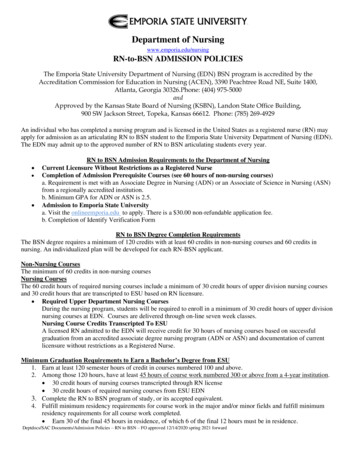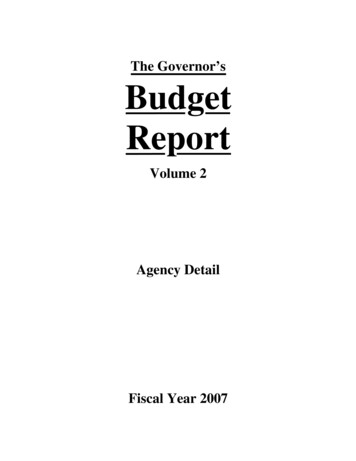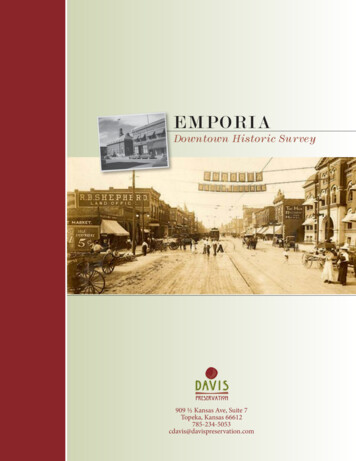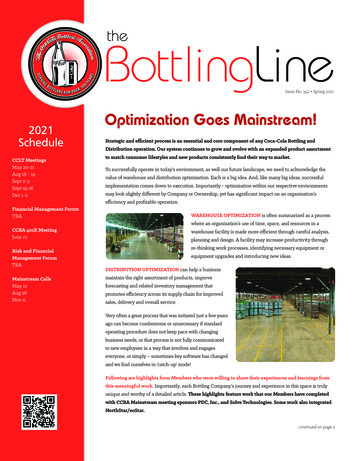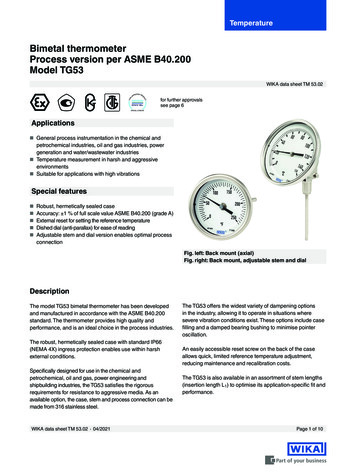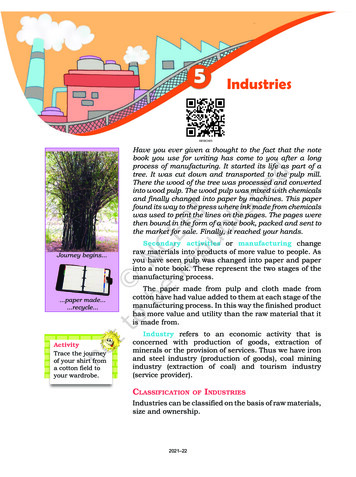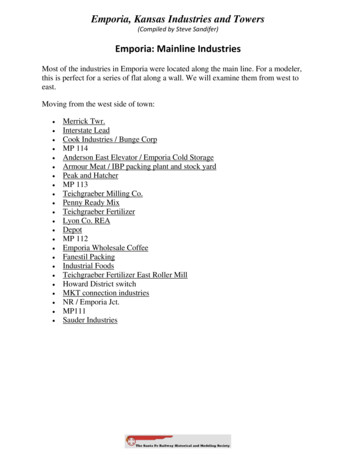
Transcription
Emporia, Kansas Industries and Towers(Compiled by Steve Sandifer)Emporia: Mainline IndustriesMost of the industries in Emporia were located along the main line. For a modeler,this is perfect for a series of flat along a wall. We will examine them from west toeast.Moving from the west side of town: Merrick Twr.Interstate LeadCook Industries / Bunge CorpMP 114Anderson East Elevator / Emporia Cold StorageArmour Meat / IBP packing plant and stock yardPeak and HatcherMP 113Teichgraeber Milling Co.Penny Ready MixTeichgraeber FertilizerLyon Co. READepotMP 112Emporia Wholesale CoffeeFanestil PackingIndustrial FoodsTeichgraeber Fertilizer East Roller MillHoward District switchMKT connection industriesNR / Emporia Jct.MP111Sauder Industries
Emporia, Kansas Industries and Towers(Compiled by Steve Sandifer)Emporia: Merrick TowerMerrick Tower and the west end of Emporia Yard, from Wheat Lines and Super Fleets by JoeMcMillan.Eastbound trains enter the west side of Emporia Yard at Merrick tower. When theoriginal east yard was removed, the line which curved away from the main was alsoremoved. The tower once controlled that end of the yard. Today it contains CTCsignal equipment for the BNSF.
Emporia, Kansas Industries and Towers(Compiled by Steve Sandifer)Photos by Victor Rance
Emporia, Kansas Industries and Towers(Compiled by Steve Sandifer)Emporia: Interstate Lead1977 CLIC book
Emporia, Kansas Industries and Towers(Compiled by Steve Sandifer)The Interstate Lead onthe west side of town wasconstructed between 1968and 1973. At first, as in the1977 CLIC above, it was aspur. A western leg wasadded to make it into awye between 1977 and1990. Locals also call it theT-bone spur because of awager over itsconstruction.
Emporia, Kansas Industries and Towers(Compiled by Steve Sandifer)Emporia Ready Mix / Meier Ready Mix is the first track. They were close to themain in 1977 but had moved up the spur and reversed their track by 1990. Theystopped receiving railshipments shortlythereafter. Their track hada pit for aggregate. By2001 they had scaleddown their operation andshare the site with anautomotive junk yard.Between 1977 and 1983,Safeway located a petfood plant on this linewith two tracks and 4doors and a pit. Theinside tracks are used forbox cars shipping productout, the outside track isfor incoming materials. In2001 the plant wasexpanding and was using5 former ATSF coveredhoppers, painted ghostgray, for storage. Theymake dog food, cat litter,and mix wild bird seed.By 1995, all industriesnorth of Safeway nolonger received railshipments. A stop hasbeen inserted between therails and trees aregrowing between the tiesnear Fleetwood.
Emporia, Kansas Industries and Towers(Compiled by Steve Sandifer)DeBauge Brothers is a Coors beer distributor. Originally, they were locateddowntown. They have a door and a dock and received beer by rail.Interstate Bakery makes Dolly Madison cakes They had two tracks. In 1977 theyhad a dock and 3 hose spots. In 2001 the tracks had been removed and the streetrepaved. At one time they received 40' Milwaukee reefers with toppings such ascoconut, small tank cars of chocolate, tanks of oil, and bulk loads of sugar.Modine makesautomotive radiators.They had 3 doors in 1977and added a dock by1983.Fleetwood had two doors.They manufacturedmobile homes andbrought in variousbuilding supplies. In 2001that building housed thepublic works departmentof the city of Emporia.There is also a spur at thetop of the Interstate Leadwhich is shown as spikedon all charts available tothe author. Theseoriginally served DiddyMfg. who made printingequipment and CrawfordMfg. who made furniture.
Emporia, Kansas Industries and Towers(Compiled by Steve Sandifer)Emporia: Mainline Industries (1)1977 CLICFrom trackside, looking north.Between the Interstate Lead and MP 114 was the Cook Industries West track.Originally it was an elevator and alfalfa mill for the Anderson Cattle Company, builtin 1943. Then Cook purchased it, and by 1983 it was the Bunge Corporation West.This is a large steel grain elevator which originally was composed of 14 large tankswith 3 smaller tanks on the north side and two small tanks between main tanks. Twospouts loaded cars. This elevator was demolished around 2005.
Emporia, Kansas Industries and Towers(Compiled by Steve Sandifer)North sideNote missing tanks, spouts, and 2 small inside tanks.A close examination will show three tanks missing on the south side. A tornado in1976 damaged these tanks and they were removed and not replaced.
Emporia, Kansas Industries and Towers(Compiled by Steve Sandifer)In November 2001, therewas no visible sign ofactivity at the elevator.North side, track is behind the buildingJust west of the elevator is a Quonset hut which served as a hay barn. It is a carrepair shop in 2001. In the pre-1970 days, virtually all of the area covered by thispage was cattle yards of the Anderson Cattle Company. Anderson began his Emporiaoperation in 1941 with a 17,000-bushel elevator and 40 acres including large sheepbarns. It was known as Emporia elevator and feeding company. The Kansas City Starof January 18, 1959, stated that Anderson had 50,000 head of cattle on the premises.
Emporia, Kansas Industries and Towers(Compiled by Steve Sandifer)Emporia: Mainline Industries (MP 114)1977 CLIC chart
Emporia, Kansas Industries and Towers(Compiled by Steve Sandifer)1983 CLICView from the east, from the cold storage parking lot.From west to east, the first industry is Anderson Elevator East, parallel to the mainand entered from the east. This industry is actually a storage barn for the AndersonCattle Company. Among other things, block salt was delivered to this location.A new industry replaces Anderson in 1983: Emporia Cold Storage. They areadjacent to the packing plant with three doors.
Emporia, Kansas Industries and Towers(Compiled by Steve Sandifer)The largest industry in this are is Iowa Beef Packers. Even though most stock wentthrough Emporia for points east, Armour had a packing plant in Emporia, located onthe north side of the yard. The Armour plant in Emporia was purchased by Iowa BeefPackers. In1967, IBP bought the plant. The Armour plant was demolished and amodern plant built on the site. This was also the time when rail shipment of cattle wasceasing. At first meat was shipped out in rail reefers. Then the facility was convertedfor refrigerated trucks with many as TOFC shipments. IBP had four tracks dedicatedto Trailers-On-Flat Cars. The potential of boxed beef was such that a processingoperation was added to the Emporia facility and opened in l970. That same year, toreflect the scope of IBP's new operations, the company's name was changed fromIowa Beef Packers, Inc. to Iowa Beef Processors, Inc.
Emporia, Kansas Industries and Towers(Compiled by Steve Sandifer)On the above CLIC chart, Tracks A-D are TOFC. Tracks 1 and 2 are for tallow andinclude 7 racks for tank cars. Track 3 is the hide track (Dennison Hide) with 3 doors.Track 4 had 4 spots and one spout. Track 5 was open.Rod Riley reported that in the days of ice reefers, about 5 36' Armour reefers weretaken into town to the Jenson Ice House for icing each day; then they returned forloading at Armour. After loading, they were again taken to Jenson for topping upbefore leaving Emporia.The last location in this area is Peak and Hatcher which had a chute and a cattleramp in 1977, a dock in 1983. Peak and Hatcher handled the cattle sales at thislocation.
Emporia, Kansas Industries and Towers(Compiled by Steve Sandifer)Emporia: Mainline Industries (MP 113)1977 CLICThe Elm Street Elevator Track served Teichgraeber Milling Company according tothe 1977 click book. It had 5 spots: molasses, 2 box unloading, hopper unloading, anda spout. By 1983, it had become Irsik & Doll and consisted of door, hose, open, door,pit, spout. This is the large concrete elevator above and was built in several stages.The rectangular feed mill was the last constructed.Penny Ready Mix was served off of the tail track which originally served the FreightHouse. They had two pits, one for sand and one for cement. By 1983, Penny hadadded a warehouse with 2 doors on Freight House track #7 where TeichgraeberFertilizer was once unloaded.Teichgraeber Fertilizer unloaded supplies on Freight House track #7 using portableequipment. In 1977 they had 3 spots: Tank unloading and 2 hoppers. By 1983 theyhad become Irsik and Doll with a hose, open, and auger.Lyon Co. REA was the third occupant of Freight House track #7. This was a pole andtransformer yard for the Rural Electric Association.By 2001, only the Elm Street elevator and Penny's cement operation remained. Thewarehouse is abandoned and everything else is gone.
Emporia, Kansas Industries and Towers(Compiled by Steve Sandifer)Emporia: Mainline Industries (MP 112)Several industries were served in old downtown Emporia, east of the depot andHarvey House.1977 CLIC
Emporia, Kansas Industries and Towers(Compiled by Steve Sandifer)The downtown industries have changed substantially through the years. On thenorth side of the track was Emporia Wholesale Coffee. It had three spots. #21 wasfor unloading coffee, #22 was a door, and #23 was for unloading potatoes, sugar, etc.Only one door remained in 1983. Today it is gone. AVCO Food now occupies thebuilding.Theodore Poehler Mercantile, from the Kansas Historical Society collection, FK2.67/E.73. Notethe loading dock below.
Emporia, Kansas Industries and Towers(Compiled by Steve Sandifer)The bumper track led off of that and served doors at Theodore Poehler MercantileCompany. This became DeBauge Brothers (the beer distributors), then EmporiaFood Inc. by 1957, then Industrial Foods. It is Carl Foods in 2001. This track was goneby 1983.East sideSouth SideNorth sideWest side
Emporia, Kansas Industries and Towers(Compiled by Steve Sandifer)Originally this track ran across Commercial St. and connected to the B&B spur. Theorigin of that name is unknown to this writer.Teichgraeber Fertilizer East,City Roller Mill Track, is next.It had a short and a long dockin 1978. By 1983, it wasowned by Irsik & Doll FeedService. Only a warehousebuilding remains today.
Emporia, Kansas Industries and Towers(Compiled by Steve Sandifer)According to CLIC books, opposite Emporia Wholesale Coffee was Fanestil PackingCompany (1977). However,Fanestil's is located south oftown, is not rail served, anddenies every having connectionin this location. However, theRich Coal Company did occupythis location until the late 60s.The track which led to it alsoserved as a team track. It wasgone by 1983.
Emporia, Kansas Industries and Towers(Compiled by Steve Sandifer)Emporia: Katy IndustriesWhen the MKT left Emporia in the mid-50s, the Santa Fe took over the few industrieson their tracks. The spur entering that industrial site left the west main opposite ofwhere the Howard District left the east main to head south.The largest industry is a soybean mill. Jack Delano took the photo below of theKansas Soybean Mill, Inc. in March 1943, as seen from the ATSF main. The plantprocessed soybeans for oil and feed. They became Cook Industries by 1977 andbecame the Bunge Corp. by 1983 and remains Bunge today.
Emporia, Kansas Industries and Towers(Compiled by Steve Sandifer)1943, looking north from the main and East St.Library of Congress, Prints & Photographs Division, FSA/OWI Collection, LC-USW3-019801-E2001 from the same location.This plant had two doors and a pit, a scale track, and a rack for soybean oil. The samefacilities have been improved and expanded. One interesting operating detail: the tailtrack for switching this industry (north end) only has a capacity for an engine and 4modern or 5 40' cars. This industry requires frequent switching. Bunge does have aroad-railer for moving cars within the plant. For more photos, click here. For more onsoybean plant operations, click here.Also, on the Katy was Smith / Mark II Lumber. They had two spots, one forunloading cement and one for unloading lumber according to the 1977 and 83 CLICbooks. Their main office was on the south side of 6th Street with some storagefacilities by the Smith Spur. In the mid-80s, Bunge purchased this property and MarkII moved a block east to new facilities with no rail service.One of the attached photos shows a Texaco bulk oil dealer on the old Katy main. Ihave not found any information on this dealer as yet.
Emporia, Kansas Industries and Towers(Compiled by Steve Sandifer)One final industry is east of Emporia Junction on the Ottawa Cutoff. That is SauderIndustries. They are custom steel fabricators who got their start in wooden oilfieldtanks in Madison. They have constructed many large water tanks for municipalitiesas well equipment for the Interstate Bakery. They have one spot for unloading sandand materials and also shipping out their products. The spur is entered from thenorth track and is switched from the west.
Emporia, Kansas Industries and Towers(Compiled by Steve Sandifer)Emporia: Bunge East2001From East street, looking northeast.
Emporia, Kansas Industries and Towers(Compiled by Steve Sandifer)From East St. and 6th St., looking southeast.Below are 5 views from 6th St. looking at the northern end of the complex.
Emporia, Kansas Industries and Towers(Compiled by Steve Sandifer)
Emporia, Kansas Industries and Towers(Compiled by Steve Sandifer)
Emporia, Kansas Industries and Towers(Compiled by Steve Sandifer)This view looks in a west-northwesterly direction from diamond of the MKT and ATSF, circa 1955. Notethe Texaco bulk oil dealer in the foreground. This is about the time the MKT withdrew from Emporia andthe ATSF took over serving this industry.Same general view in 2001.
Emporia, Kansas Industries and Towers(Compiled by Steve Sandifer)Emporia: Soybean processingDr. Emerson D. Nafziger, Crop Sciences, University of Illinois, reports: " The early 1940'swould have been early in the adoption of soybean as a commercial cash crop, and so acreage inthe Midwest would have been starting to grow, but it was probably not very high. I suspect thismight have been the only soybean processing mill in KS at the time, or it was surely one of thefew. South central KS and eastern KS (with higher rainfall) were probably the where most of thecrop was grown, so I would assume that most of the soybeans might have come into Emporiafrom other places in KS. No nearby state would have had huge surpluses at the time, though themarket for soy oil and meal was only starting to grow, so there were probably few processors.""Soybeans are about 20 percent oil, and each bushel (60 lb.) would produce about 12 LB of oil,which is just under two gallons. On a volume basis, a bushel is about 1.25 cubic ft and at 7 LBper gallon (a guess - I can't lay my hands on the actual density) the oil from a bushel wouldoccupy about a fourth of a cubic foot, so the ratio of whole soy volume to extracted oil volumewould be about 5.4 to 1. Most of the rest of the product from an extraction plant would besoybean meal, which because it is crushed would probably be denser than whole soybeans andreduced to about 75 percent of its initial weight be removal of the hull and oil. Hull, at somethinglike 3 or 4 percent (?) would have been hauled away, but I'm not sure what use would have beenmade of it.""Without knowing the capacity of the mill at the time in question it will be difficult to guess atthe rates of feedstock and product movement. I note that the silo cluster was added after the timeyou refer to, and it appears that storage capacity was then quite small. That means that therewould have had to be pretty constant movement on the tracks to keep the mill supplied. Today,there's likely a lot of truck haul-in, but in 1943 there was probably very little."Mark Amfahr added, "A modern soybean crushing operation produces (for every 100 tons ofsoybeans crushed) roughly 75 tons of soybean meal, 18 tons of soybean oil, and 7 tons of otherproducts, such as hulls, etc. Except for the truck shipments, the meal and other dry products goout by covered hopper while the oil leaves the plant in tank cars. If I had to guess, I'd say that1950's operations would have been similar except for a smaller % of oil output vs. today. Dryproducts would have probably left mostly in boxcars while oil would have been shipped either intank cars or as a packaged product in boxcars."Larry Jackman added, "You will also need inbound tank cars of H2SO4 (sulfuric acid. They usethat to extract the oil from the beans."Based on the above, 1950s operations would look something like this. 10 box cars of soybeanswould enter the plant (1,000 tons) from the west. Once processed, 6 8,000 gal. tank cars of oil, 7boxcars of meal, and 1 boxcar of hulls would be loaded for removal. The oil would probablyhead east, while the meal was used largely for cattle feed and could go any direction. No one hasexplained the use for the hulls yet. I am uncertain of the H2SO4 required for this operation, but Iexpect it to be minimal.
Emporia, Kansas Industries and Towers(Compiled by Steve Sandifer)Emporia: Emporia (NR) JunctionLibrary of Congress, Prints & Photographs Division, FSA/OWI Collection, LC-USW3-019801-E, by JackDelano.
Emporia, Kansas Industries and Towers(Compiled by Steve Sandifer)1935 Junction record.Emporia Junction, also known as NR Junction, is located on the east side of Emporiaand originally was where the MKT and the ATSF crossed. The Katy track can be seenin the Delano photo above. The Katy is now gone and the industries which it onceserved are now served by the ATSF (BNSF).Emporia Junction is known today as the place where the old main to Topeka and theOttawa Cutoff come together. The wye in this location was used to turn the largerlocomotives which would not fit on the 120' turntable. The east leg of the wye is nowhistory also.
Emporia, Kansas Industries and Towers(Compiled by Steve Sandifer)Emporia: Yard TowerIn the middle of the Yard lay an unusual yard office / tower. I hope someone will beable to provide us with better photographs. The tower was an extension of a twostory office building.The tower can be seen over S-4 1510 in this 1967 photo by Bill Gibson.
Just west of the elevator is a Quonset hut which served as a hay barn. It is a car repair shop in 2001. In the pre-1970 days, virtually all of the area covered by this page was cattle yards of the Anderson Cattle Company. Anderson began his Emporia operation in 1941 with a 17,000-bushel elevator and 40 acres including large sheep barns.



